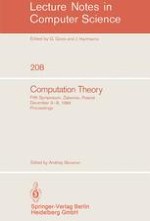1985 | Buch
Computation Theory
Fifth Symposium, Zaborów, Poland December 3–8, 1984 Proceedings
herausgegeben von: Andrzej Skowron
Verlag: Springer Berlin Heidelberg
Buchreihe : Lecture Notes in Computer Science
Enthalten in: Professional Book Archive
